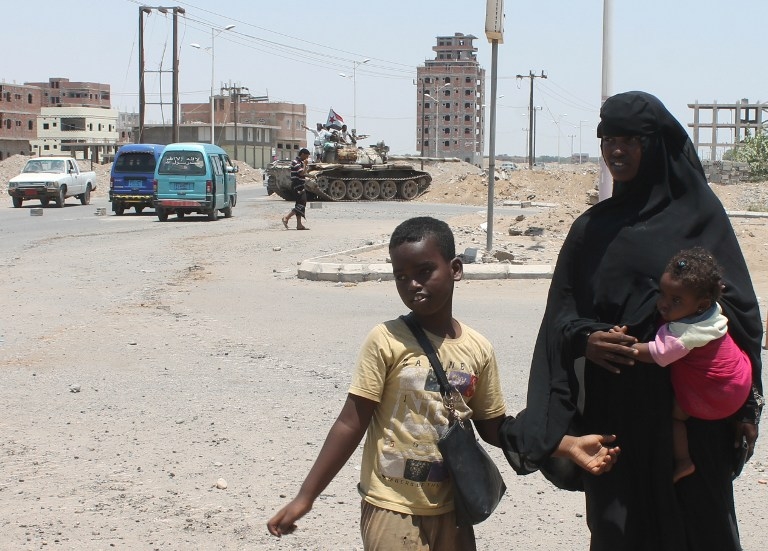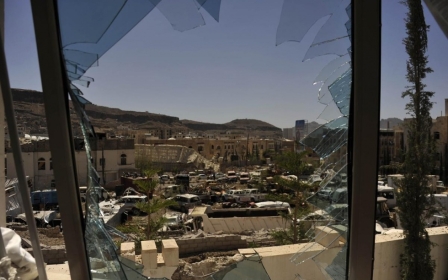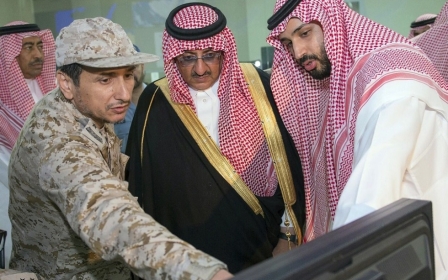No end in sight to the fight in Yemen

A few days after Saudi Arabia started bombing Yemen last month, a friend of mine from the port city of Aden began sending me distressing images. “The situation is appalling,” Mohamed said in an email. “Everyone’s afraid of getting killed by air strikes … This is more than we can get used to.”
The photographs were a mixture of high-quality stills from local news sites and blurred, amateur shots pulled from his friends’ Facebook pages. Some of the scenes were similar to those I saw when I lived in Yemen in 2012: cars snarled on a highway in a day-long queue for petrol; a teenage boy in army fatigues holding a Kalashnikov.
Others looked more like Gaza or Somalia than the Yemen I’d known: a dog roaming a street strewn with bodies, a family boarding a boat for Djibouti, a dairy factory in flames, a sheikh standing by a ruined house, the body of a child in his arms.
“I’ll keep sending you updates,” Mohamed wrote. “People are so scared.”
When Saudi Arabia announced on Tuesday that it was ending its bombing campaign, known as Operation Decisive Storm, intended to roll back Houthi rebels and reinstate Yemen’s exiled president, Abd Rabbu Mansour Hadi, I contacted Mohamed for his reaction.
After a month of living under siege, with daily power outages and gunfights across his city, I had expected him to be relieved. “It’s not over,” he told me. “The Houthis are still here. So much damage has been done.”
Then a Saudi spokesman announced a new, more limited offensive – Operation Restoration of Hope, aimed at rebuilding the country while preventing the Iran-allied Houthis from operating – but within hours renewed fighting had broken out in Aden. Further air strikes pounded a military base near Taez, which had been seized by Houthi fighters earlier in the day.
When Saudi Arabia does finally end its foray into neighbouring Yemen, the oil-rich kingdom will leave behind a deeply impoverished country that is coming apart at the seams. There are water shortages, separatist movements, al-Qaida militants and an ousted president still at large: none of these problems will have gone away and many will have been exacerbated by the air strikes.
As Saudi officials begin to assess how far they have pushed back the Houthis, the rest of Yemen will be counting the cost. The fighting has killed 1,080 people, many of them women and children, according to the World Health Organisation. An air and naval blockade, which for weeks prevented the country’s international airports from operating and vital aid from getting to those in need, has brought Yemen’s already crippled economy to its knees. Bakeries have no bread and hundreds of vaccines for preventable diseases have been thrown away because fuel, powering the refrigerators they were kept in, ran out.
At the same time, diplomatic efforts have stalled. Jamal Benomar, an astute Moroccan diplomat from the UN who played a key part in arranging former president Ali Abdullah Saleh’s exit in 2011 and negotiated (some would say, too willingly) with the Houthis when they stormed the capital last year, has resignedand returned to New York, leaving Yemen rudderless.
The Saudis may have succeeded in pushing back the Houthis in the east and in demolishing some of their vast armoury – much of which was originally looted from US-supplied army bases – but Yemen’s capital, Sana’a, remains in Houthi hands. For the Houthis, the Saudis’ withdrawal announcement has been seen as a victory and Houthi supporters in Sana’a, who number in the hundreds of thousands, are celebrating in the streets.
Perhaps most troubling of all is the emergence of a sectarian discourse, previously unknown in Yemen. A translator in Aden, who I worked with in 2011, last weekspoke in a divisive language that I have never heard before. “I am with the air strikes because the air strikes are not against me and my people and my sect. They are against the Houthis and the Shias who are supported by Iran,” he said.
Separatist leaders in the south, some of whom governed the Middle East’s only communist state before unification with the north in 1990 and who have long clamoured for independence, vowed on Wednesday to fight the Houthis with or without the support of Saudi jets and weaponry.
The north has been the target of what Saudi Arabia has called “precision bombing”. Army bases, airports and missile depots have been hit. But the strikes have often gone astray. Factories, football stadiums, schools, palaces and government buildings have been destroyed as well, fuelling resentment and boosting the Houthis’ cries that Yemen, not the Houthis, is under attack.
Yemen’s vice-president, Khaled Bahah, an Indian-educated diplomat who backed the 2011 uprising and whom some are touting as a consensus man to replace Hadi, will face a near-impossible task of bringing factions who have been hurling rockets at each other, back to the negotiating table.
If and when Saudi Arabia declares the war over, there are few reasons to believe that the fight for Yemen will end there.
This week, Mohamed sent me a video showing a man in a Sana’a street strewn with bodies, debris and broken glass. “Prophet Mohammed said ‘I prefer to see the Kaaba destroyed stone by stone over the spilling of a Muslim’s blood’,” shouts the man, spitting with rage and jabbing his forefinger at the camera. “We will not let it go, O Salman,” he says, referring to Saudi’s newly anointed king. “We will not let it go.”
This column first ran in The Guardian's Comment is Free section.
- Tom Finn graduated from the School of Oriental and African Studies in 2010 and then moved to Sanaa, Yemen. He worked as an editor at the Yemen Times and later as a freelancer reporting for the Guardian and Reuters on the uprising that ended the 33-year rule of Ali Abdullah Saleh. In 2013, he reported from Egypt on the military’s overthrow of president Mohammed Morsi. A recipient of the Fulbright Alistair Cooke Award, he has an MA in Journalism and Near Eastern Studies from New York University.
The views expressed in this article belong to the author and do not necessarily reflect the editorial policy of Middle East Eye.
Photo: A woman with children walks past militiamen, loyal to Yemen's fugitive President Abd Rabbuh Mansour Hadi, standing on a tank and holding a Southern Separatist movement flag, in the port city of Aden's Dar Saad suburb, on 22 April 2015 (AFP)
New MEE newsletter: Jerusalem Dispatch
Sign up to get the latest insights and analysis on Israel-Palestine, alongside Turkey Unpacked and other MEE newsletters
Middle East Eye delivers independent and unrivalled coverage and analysis of the Middle East, North Africa and beyond. To learn more about republishing this content and the associated fees, please fill out this form. More about MEE can be found here.






